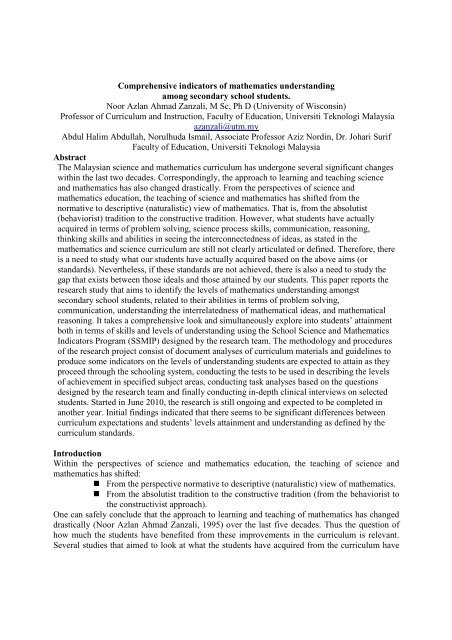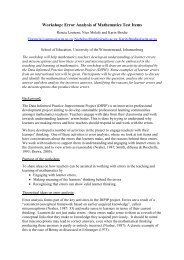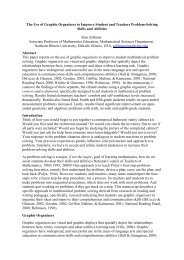Comprehensive indicators of mathematics understanding among ...
Comprehensive indicators of mathematics understanding among ...
Comprehensive indicators of mathematics understanding among ...
Create successful ePaper yourself
Turn your PDF publications into a flip-book with our unique Google optimized e-Paper software.
<strong>Comprehensive</strong> <strong>indicators</strong> <strong>of</strong> <strong>mathematics</strong> <strong>understanding</strong><strong>among</strong> secondary school students.Noor Azlan Ahmad Zanzali, M Sc, Ph D (University <strong>of</strong> Wisconsin)Pr<strong>of</strong>essor <strong>of</strong> Curriculum and Instruction, Faculty <strong>of</strong> Education, Universiti Teknologi Malaysiaazanzali@utm.myAbdul Halim Abdullah, Norulhuda Ismail, Associate Pr<strong>of</strong>essor Aziz Nordin, Dr. Johari SurifFaculty <strong>of</strong> Education, Universiti Teknologi MalaysiaAbstractThe Malaysian science and <strong>mathematics</strong> curriculum has undergone several significant changeswithin the last two decades. Correspondingly, the approach to learning and teaching scienceand <strong>mathematics</strong> has also changed drastically. From the perspectives <strong>of</strong> science and<strong>mathematics</strong> education, the teaching <strong>of</strong> science and <strong>mathematics</strong> has shifted from thenormative to descriptive (naturalistic) view <strong>of</strong> <strong>mathematics</strong>. That is, from the absolutist(behaviorist) tradition to the constructive tradition. However, what students have actuallyacquired in terms <strong>of</strong> problem solving, science process skills, communication, reasoning,thinking skills and abilities in seeing the interconnectedness <strong>of</strong> ideas, as stated in the<strong>mathematics</strong> and science curriculum are still not clearly articulated or defined. Therefore, thereis a need to study what our students have actually acquired based on the above aims (orstandards). Nevertheless, if these standards are not achieved, there is also a need to study thegap that exists between those ideals and those attained by our students. This paper reports theresearch study that aims to identify the levels <strong>of</strong> <strong>mathematics</strong> <strong>understanding</strong> <strong>among</strong>stsecondary school students, related to their abilities in terms <strong>of</strong> problem solving,communication, <strong>understanding</strong> the interrelatedness <strong>of</strong> mathematical ideas, and mathematicalreasoning. It takes a comprehensive look and simultaneously explore into students’ attainmentboth in terms <strong>of</strong> skills and levels <strong>of</strong> <strong>understanding</strong> using the School Science and MathematicsIndicators Program (SSMIP) designed by the research team. The methodology and procedures<strong>of</strong> the research project consist <strong>of</strong> document analyses <strong>of</strong> curriculum materials and guidelines toproduce some <strong>indicators</strong> on the levels <strong>of</strong> <strong>understanding</strong> students are expected to attain as theyproceed through the schooling system, conducting the tests to be used in describing the levels<strong>of</strong> achievement in specified subject areas, conducting task analyses based on the questionsdesigned by the research team and finally conducting in-depth clinical interviews on selectedstudents. Started in June 2010, the research is still ongoing and expected to be completed inanother year. Initial findings indicated that there seems to be significant differences betweencurriculum expectations and students’ levels attainment and <strong>understanding</strong> as defined by thecurriculum standards.IntroductionWithin the perspectives <strong>of</strong> science and <strong>mathematics</strong> education, the teaching <strong>of</strong> science and<strong>mathematics</strong> has shifted: From the perspective normative to descriptive (naturalistic) view <strong>of</strong> <strong>mathematics</strong>. From the absolutist tradition to the constructive tradition (from the behaviorist tothe constructivist approach).One can safely conclude that the approach to learning and teaching <strong>of</strong> <strong>mathematics</strong> has changeddrastically (Noor Azlan Ahmad Zanzali, 1995) over the last five decades. Thus the question <strong>of</strong>how much the students have benefited from these improvements in the curriculum is relevant.Several studies that aimed to look at what the students have acquired from the curriculum have
een conducted. These studies, however, have been generally looked at skills acquired at specificarea or level and thus are limited in scope.This proposed study aims a more comprehensive look and simultaneously probe into students’attainment both in terms <strong>of</strong> skills and levels <strong>of</strong> <strong>understanding</strong>. The inquiry into and creating theSchool Science and Mathematics Indicators Program (SSMIP) will produce comprehensive andcomputerized guidelines on school-leavers achievement <strong>indicators</strong> in both science and<strong>mathematics</strong>. Potential users will include all higher institutions <strong>of</strong> learning both public andprivate institutions, and individual science and <strong>mathematics</strong> educators. While this type <strong>of</strong> schoolachievement <strong>indicators</strong> are quite common in developed countries, they are, however, new in theMalaysian scenario.The basic principles <strong>of</strong> assessmentThe word assessment refers to the process <strong>of</strong> collecting and using evidence about students’learning. Assessment and evaluation both describe the processes <strong>of</strong> collecting and interpretingevidence for some purpose. They both involve decisions about what evidence to use, thecollection <strong>of</strong> that evidence in a systematic and planned way and the interpretation <strong>of</strong> the evidenceis to produce to produce some <strong>of</strong> judgment (Harlen, 2007, Harlen2008, Khodori, 200; Salvia, J.&Ysseldke. J. E. 2001).This description is illustrated by the following diagram:In a nutshell “Educational assessment is formal attempt to determine students’ status with respectto educational variables <strong>of</strong> interest (Popham, 2006; pg 6)In recent years educators have been urged to broaden their conception <strong>of</strong> testing so students’status determined via a wider variety <strong>of</strong> measuring devices – a variety extending well beyond thetraditional paper-and-pencil tests. Thus they are many worthwhile learning outcomes not bestmeasured by paper-and-pencil tests. Assessment is a broader descriptor <strong>of</strong> the kinds <strong>of</strong>educational measuring teachers do – a descriptor that, while certainly including traditional pap erand pencil tests, covers many more kinds <strong>of</strong> measuring procedures.Noor Azlan Ahmad Zanzali (2005) emphasized assessment must be based and address severalcritical issues <strong>of</strong> teaching and learning. They areIssue 1: Underlying assumptions about the philosophy and goals <strong>of</strong> the curriculumIssue 2: Assessment must be in consonance with current learning and instructionalconsiderationsIssue 3: Specifications <strong>of</strong> performance standardsIssue 4: Developing authentic tasksIssue 5: Assessment should measure status and growthIssue 6: Scoring and what form?Issue 7: Reporting –making publicObjectives <strong>of</strong> the ResearchThis research program aims to identify the levels <strong>of</strong> <strong>mathematics</strong> <strong>understanding</strong> <strong>among</strong>st secondary school students,corresponding to their levels <strong>of</strong> schooling students’ abilities to acquire a variety <strong>of</strong>mathematical concepts,
The abilities to carry out a variety <strong>of</strong> mathematical procedures and to use them tosolve problems in both familiar and unfamiliar situations. The skills and <strong>understanding</strong> that students are expected to acquire as stipulated bythe curriculum expectations. The levels <strong>of</strong> problem solving abilities, communication, <strong>understanding</strong> theinterrelatedness <strong>of</strong> mathematical and science, and mathematical and scientificreasoning.A complete guideline on the levels <strong>of</strong> students’ <strong>understanding</strong> in science and <strong>mathematics</strong>according the levels <strong>of</strong> schooling will be produced.For each component (<strong>mathematics</strong> and science) students will be assessed at three levels.Each level is related to the <strong>understanding</strong> <strong>of</strong> concepts, application, and problem solvingin the respective content areas. Level 1 – describing the early stages <strong>of</strong> mathematical and scientific knowledgetypical in a secondary school. Level 2 - describing the mathematical and scientific knowledge acquired in theintermediate years <strong>of</strong> secondary schooling. Level 3 - describe knowledge and skills acquired by students who have completedthe full range <strong>of</strong> <strong>mathematics</strong> and scientific courses typical <strong>of</strong> a secondary schooleducationMethodologyThe research team will consist <strong>of</strong> 4 groups, each looking at the areas <strong>of</strong> <strong>mathematics</strong>, physics,chemistry and general science areas.The methodology and procedures <strong>of</strong> the research project are as follows:1) Document analyses <strong>of</strong> curriculum material and guidelines to produce guidelines on thelevels <strong>of</strong> <strong>understanding</strong> students are expected to attain as they proceed through theschooling system2) Designing the tests to be used in describing the levels <strong>of</strong> achievement in specified subjectareas.3) Conduct task analyses based on the questions designed in (2).4) Conducting in-depth clinical interviews on selected students.Both the quantitative and qualitative methods will be used. Quantitative Method: Sets <strong>of</strong> mathematical questions to be answered by students foreach level. Coding procedures will be used to assess levels <strong>of</strong> <strong>understanding</strong>. Tests <strong>of</strong>questions will be designed by each group. Qualitative Method: Qualitative procedures such document analyses, interviews,observations, task analyses and small group interactions <strong>of</strong> selected <strong>of</strong> studentsInitial Results:At this juncture, the process <strong>of</strong> collecting is still at the initial stages.Document analyses are seen through the content, the psychological and the pedagogicalperspectives. Our initial analyses do indicate that the intended curriculum places heavy emphasison naturalistic view <strong>of</strong> <strong>mathematics</strong> based on constructivist nature <strong>of</strong> teaching and learning. Theuse <strong>of</strong> problem solving, communication, integration and reasoning <strong>of</strong> <strong>mathematics</strong> ideas areheavily emphasized. Two questions need to be addressed. First are the elements emphasized in
teaching and learning? Second, do the students attain those elements as they go through theteaching and learning processes? The answers to the first questions are discussed in my earlierpapers. This research attempts to address the second questionWe conducted a qualitative survey on the views and attitude <strong>of</strong> the students, who are oursubjects. Initial findings indicate that they do attain above average attitude as expected by thecurriculum.The results <strong>of</strong> other procedures is still being conducted and we hope to be able to collect andanalyze at the end <strong>of</strong> the year,ConclusionThe need to assess students’ achievements in terms <strong>of</strong> the elements as emphasized curriculum,but not evaluated by the paper and pencil tests in the high-stake public examinations, is still veryimportant. This will indicate the attainment <strong>of</strong> students as expected and regarded as the keyelements <strong>of</strong> learning <strong>mathematics</strong> by the curriculum.ReferencesBlack, B. and Willian, D (2008) in Harlen, W. (editor) Volume 1: Student Assessment andTesting (Sage Publication, Los Angeles)Dochy, F. J. R. C., Moerkerke, G & Martens, R. ( 2008) Integrating assessment, Learning andInstruction: Assessment <strong>of</strong> Domain-Sspecific and Domain- Transcending Prior knowledge andprogress. In Harlen, W. (editor) Volume 1: Student Assessment and Testing (Sage Publication,Los Angeles)Harlen, W. (2007) Assessment and Learning, Sage PublicationsHarlen, W. (2008) Editors introduction in Harlen, W. (editor) Volume 1: Student Assessmentand Testing (Sage Publication, Los Angeles)Khodori, M (2001) The cognitive assessment. Paper presented at the meeting <strong>of</strong> MUSLEHeducators. Kuala Lumpur.Noor Azlan Ahmad Zanzali (2005) The continuing assessment issues in <strong>mathematics</strong> education.Plenary paper presented at the East Asia Conference in Mathematics education. UniversityScience Malaysia.Noor Azlan Ahmad Zanzali (2008) Continuing issues in <strong>mathematics</strong> education. The MalaysianPaper presented at the 8 th Conference <strong>of</strong> the <strong>mathematics</strong> education in the 21 st Century.Charlotte. North Calorina. USAPopham, WQ. James (2008) Classroom Assessment: What Teachers Need to Know 5 th EditionSalvia, J and Yaseldyke, J.E (2001) Curriculum based assessment; 3 rd Edition (New York, USAMacmillan







